PRI SHOW REPORT: Show-stopping Innovations
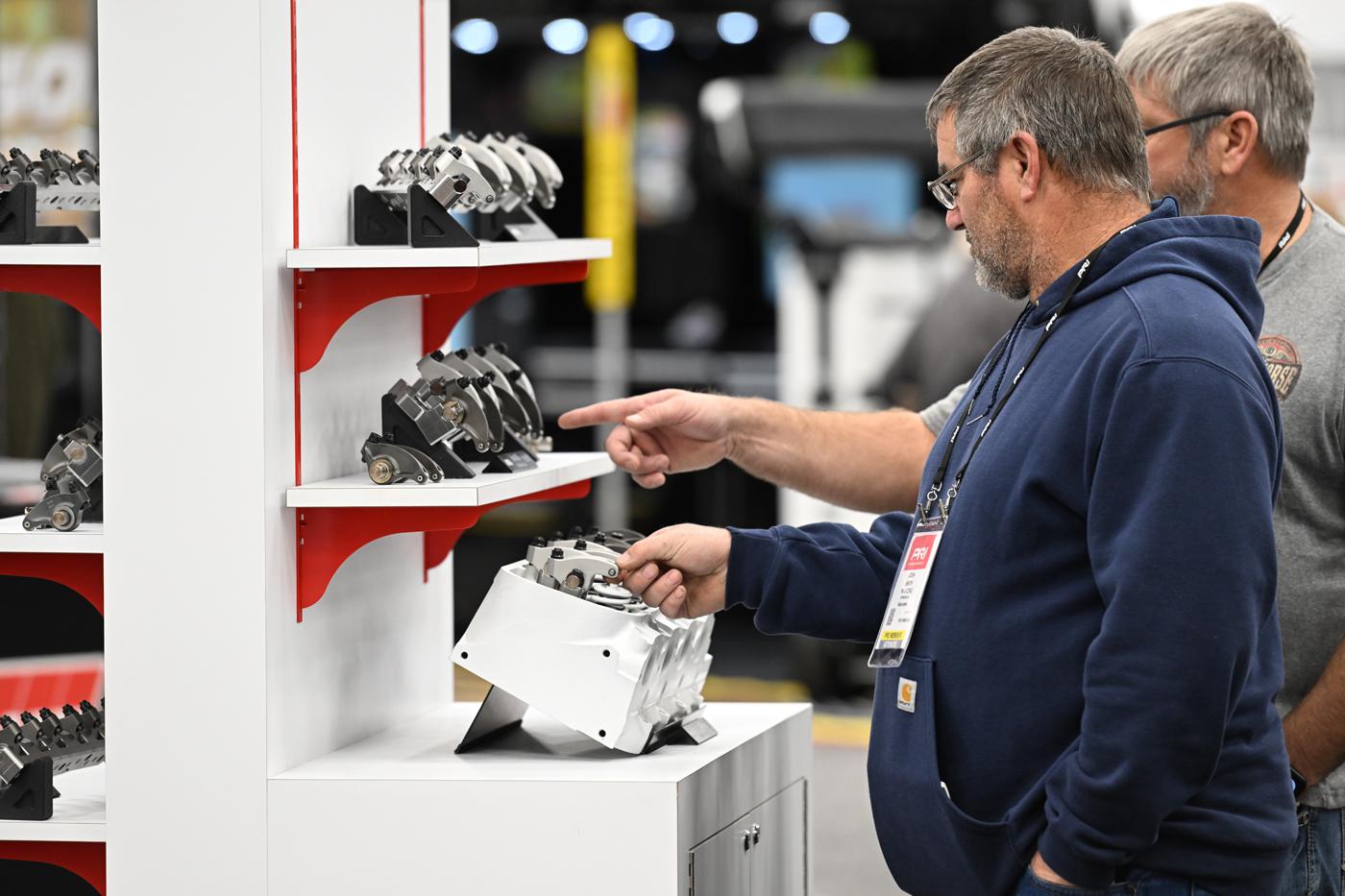
Speed merchants will be busy this year making sure high-horsepower engines don’t get thirsty, and that the growing Godzilla family will have plenty of trick parts to keep it company.
As if there wasn’t already enough interest in Ford’s Godzilla engine platform, son of Godzilla will ensure the fire-breathing monster is in the forefront of aftermarket product development heading into the 2023 season.
Other priorities for performance and racing companies include improved fuel-delivery products to keep up with the ever-increasing demands of new power-adder engine combinations, as well as more use of sophisticated simulators to expedite driver development and preparation before races.
“With the horsepower level that we’re seeing these days, the racers need a real fuel system in the car,” said Phillip VanBuskirk of Aeromotive, Lenexa, Kansas, which is developing high-performance fuel components for race cars and late-model production cars like the Ford Mustang. “We’re really stepping up the game for stock fuel tanks. They want a high-horsepower pump that can go into a stock tank, and they want brushless with a speed controller that can be tied to the ECU.”
“Driving simulators will be the wave of the future to help drive down costs,” promised David Smith of Shockwave Motorsports, Sidney, British Columbia, Canada, which manufactures race car simulators suitable for NASCAR, ARCA, Trans-Am, Late Models, and sprint car training. A typical setup includes body, roll cage, window net, dash, steering, and seating similar to the desired race car. On-track realism is achieved through three 75-inch high-def TVs, fully programmable travel vibrations, adjustable torque steering and even in-helmet sound. “It’s one more tool for developing drivers,” added Smith.
Sharp-eyed observers at the recent PRI Trade Show also picked up on other trends that race-equipment manufacturers are indicating will be key to a successful year. Addressing high-horsepower demands is certainly a priority. Transmissions will have to be more robust to handle the power that bigger turbos and superchargers will deliver. Hub dynos that measure that horsepower will be essential to some teams. Innovations that save time in the garage or pits will also be embraced, and even companies that simply help racers get the race cars from the shop to the track are promising more comfort and utility.
“What’s going to drive the market will be high-end features,” said Terry O’Neill of Bravo Trailers, Bristol, Indiana. “Everybody wants good quality and on-time delivery. They don’t want a base trailer that they have to add features on their own to the trailer to the level that meets their needs. Everything is driven toward custom.”
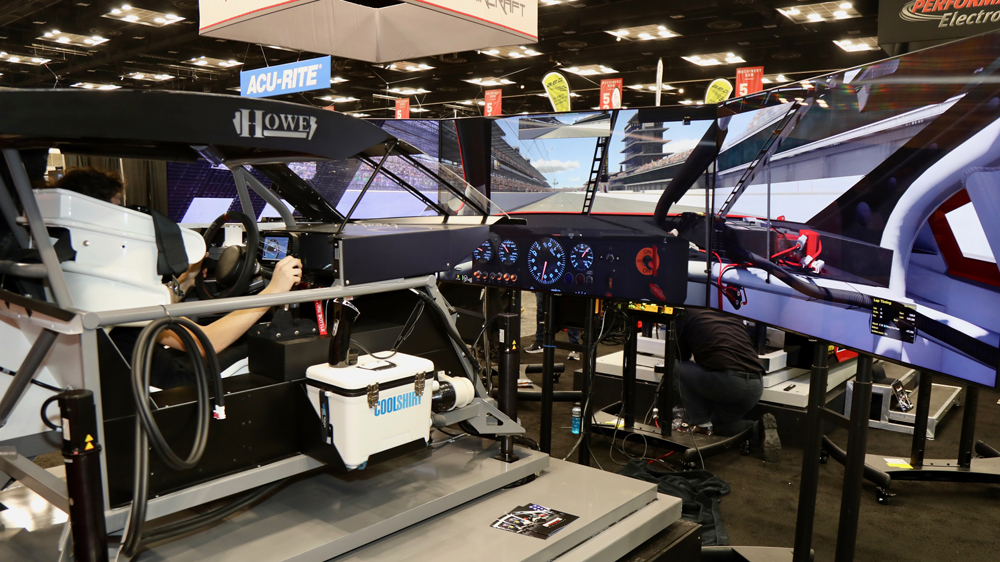
Such an example would be double doors on the back of a trailer that can be closed with the ramp down. This provides privacy in the trailer and allows the climate controls to work more efficiently. Other features important to racers will be charging stations and reliable Internet connectivity.
“Trailers being ordered will have a high level of high-end features to start with, and then the customer will add a few extras to personalize it,” added O’Neill.
A Monster Platform
If new-product releases are an indication of the most popular engine in the country right now, then many of those race trailers will haul cars powered by the Ford Godzilla engine. And very soon a more powerful relative will be on many wish lists.
Dubbed the Megazilla, the new 7.3-liter crate engine will offer 615 horsepower and 640 lbs.-ft. of peak torque, with 500 lbs.-ft. or more reportedly available from 2,500 to 6,000 rpm, Ford said. The original headliner, Ford’s Godzilla crate engine, is also 7.3 liters and is rated at 430 horsepower with 475 lbs.-ft. of peak torque.
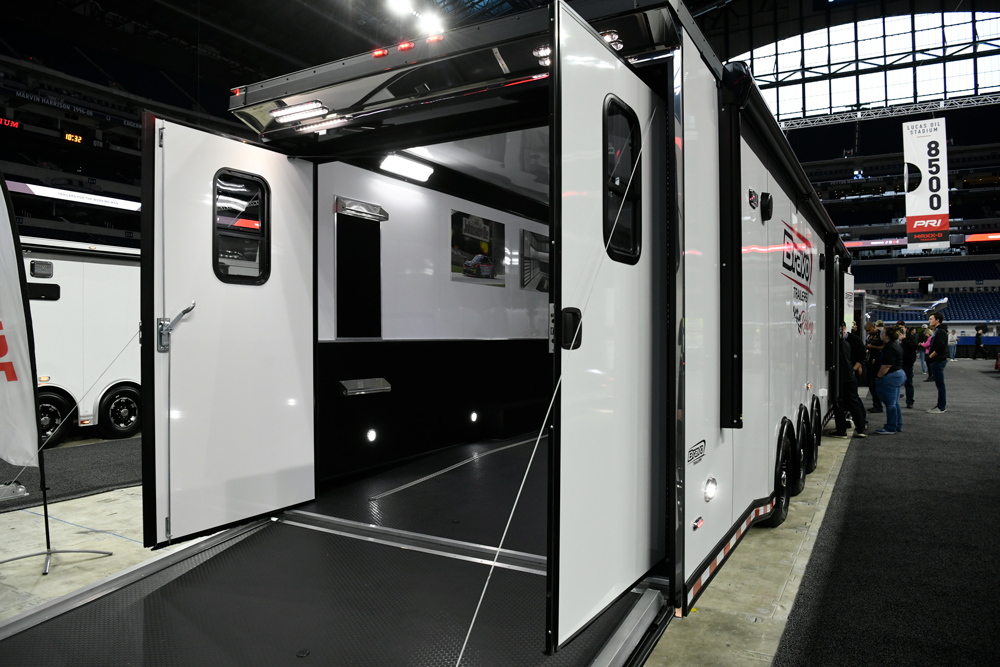
“We wanted to take Godzilla to the next level,” said Mike Goodwin of Campbell Marketing and Communications, which works with Ford Performance. “So we kicked off a program to make more power and still keep it naturally aspirated.”
One of the first moves was a new intake manifold that repositioned the throttle body to avoid hood interference in popular swaps. Ford also swapped out the truck 80-mm throttle body for a GT500 92-mm model.
“We upgraded to MAHLE pistons and Callies H-beam connecting rods,” added Goodwin. “The heads are CNC ported, and we changed the camshaft.”
Goodwin said Megazilla will be available in Q2 2023, and that many of the individual power parts that go in the engine will also be available separately.
By coincidence, Mast Motorsports of Nacogdoches, Texas, can offer a sneak peek at the camshaft and cylinder heads because it is the supplier. If you need confirmation that the Godzilla platform is red hot in the market, just ask the engine builders at Mast.
“Right now, the ratio between LS, LT, and Godzilla engines that we’re selling is equal,” said Jason Youd.
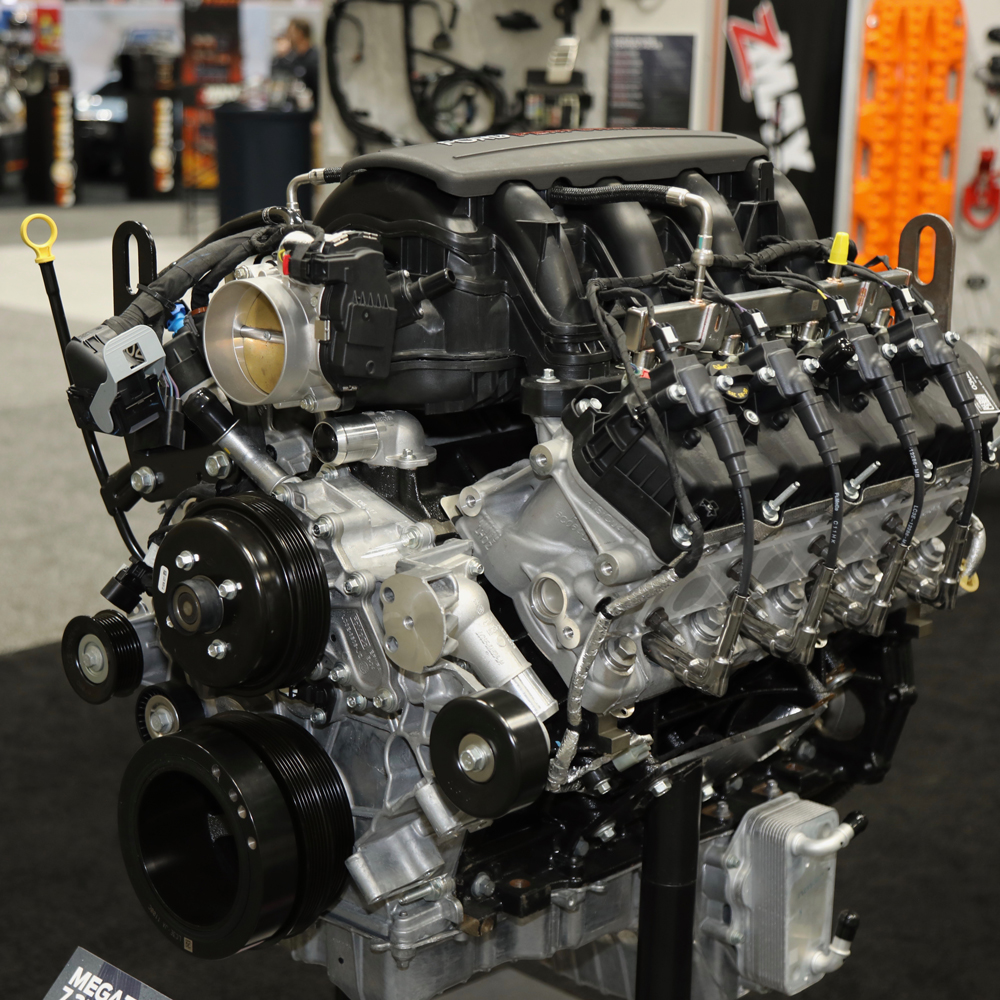
One of the neatest tricks from Mast for the Godzilla engine—which Ford originally developed as the base engine in the Super Duty pickup—is a two-piece, long runner intake manifold. The unique design actually has the runner lengths continuing inside the plenum.
“It was designed with a little CFD help and a lot of knowledge leveraged from our other projects,” said Youd.
A sampling of other leading aftermarket companies reveals significant Godzilla development programs. A billet dry-sump pan and oil pump are available from Dailey Engineering in Temecula, California. “Right now, all we have is a race version, but we’ll do a more production style kit soon. A dry sump will be more effective for swaps because it can tighten up the pan clearance,” said Bill Dailey.
Late Model Engines of Houston, Texas, has introduced a front timing cover with distributor provision. “We’re excited for the Godzilla platform,” said Bryan Neelen. “Our cover features an integrated, high-volume gerotor pump with billet gears, single-roller billet timing set and it can support a MSD distributor so the user can run a carburetor. The cover also has integrated motor plate mounts for racing applications.” Future Godzilla ideas include a retro-style oval air cleaner and valve covers that are reminiscent of 1960s Ford engines.
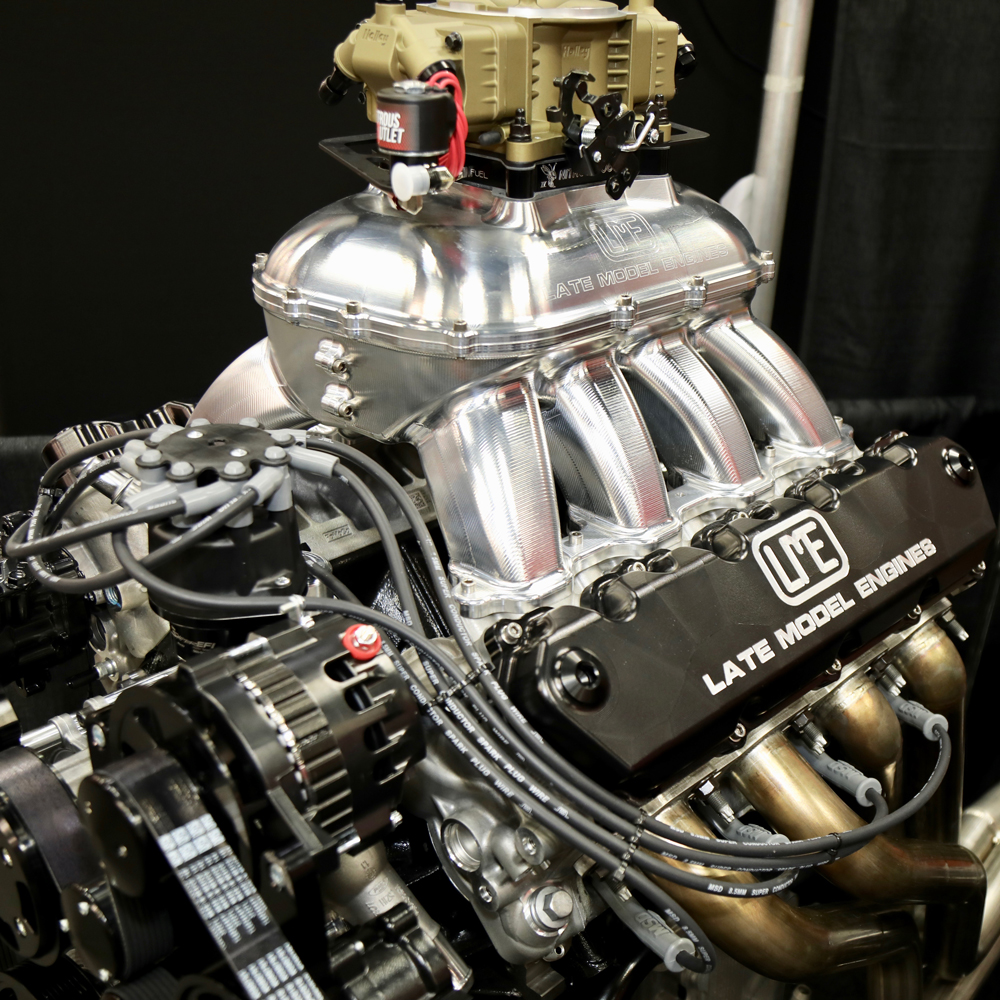
Fox body headers and stainless-steel header flanges for Godzilla swaps are available from Ultimate Headers in Berea, Ohio. “These header flanges are investment cast to allow very tight radius and large header tubes. The 321 stainless steel is stronger and resists thermal fatigue,” said Jim Browning.
Meeting Power Demands
As noted earlier, competitors obsessed with both horsepower and boost will need a constant reminder to pay more attention to their fuel system.
“They better be,” said Aaron Suchy of Radium Engineering, Clackamas, Oregon. “Neglecting the fuel system is a terrible idea, although fuel sometimes gets left behind.”
Aftermarket companies are developing improved versions of every component in a fuel system, including fuel tanks, pumps, hoses, fittings, regulators, injectors, and carburetors. It’s all part of keeping up with the power demands of the engine.
“One thousand horsepower is the norm on the street these days,” noted Suchy. “We’re adding ‘smarts’ to their fuel systems. These new parts are useful and good looking. They’re not an afterthought.”
DeatschWerks in Oklahoma City, Oklahoma, has new fuel rails for popular import vehicles and a new voltage booster to get more fuel in the system.
“We have two models, one for brushless or brushed fuel pumps,” said Krista Lamb, adding that a new 2-liter competition surge tank is designed for up to three pressure fuel pumps and fits in a standard 6x10 fuel-cell opening. “It will support up to 2,200 horsepower.”
Where’s all this power coming from, and what does the coming year look like for new power products? Adapting nitrous to late-model performance engines is one way.
Dodge Hellcat engines with a 3.0-liter supercharger already make more than 800 horsepower, but if you want to “squeeze” a little more out of the 6.2-liter powerplant, then Nitrous Outlet of Waco, Texas, has CNC-machined nitrous plates that are sandwiched between each cylinder head and the blower. Jetting for up to an additional 130 to 400 horsepower is available.

“We feed both ends of the plates because you can’t run a single passage line through each side,” said Clifton Winkleman. “The big challenge was getting the correct discharge angle for even distribution.”
Superchargers and turbochargers are getting bigger and more efficient, and even a little more affordable. Precision Turbo & Engine in Crown Point, Indiana, introduced a next-generation 122-mm turbocharger that features an innovative one-piece center housing and compressor backplate design. The company is also releasing a pair of mirror-image turbos for those racers who like a symmetrical appearance in the installation.
“Previously these were available only with ball bearings,” said Reggie Wynn. “Now they’re available with hydrodynamic journal bearing center sections that are more budget friendly.”
Wynn also noted that more class-specific turbos will be developed over the years. These turbos will have wheel sizes that fit the rules but are designed for maximum efficiency within those rules. He also said safety items like Kevlar turbo blankets will become more popular and possibly required by rules.
Last year ProCharger of Lenexa, Kansas, introduced the F4X supercharger with a 140-mm impeller. Now that top-level blower can be ordered with an even larger 144-mm impeller to help engines exceed 4,000 horsepower. On a different level, ProCharger has a modular accessory front-drive system for LS engines that allows the user to add power steering, air conditioning, and a supercharger at any time.
“It’s a great kit for swaps,” noted Grant Jones.
Support for all the higher-horsepower applications will come from many sources. ATI Performance Products in Gwynn Oak, Maryland, is introducing a lockup input drum conversion kit for the Turbo 400 transmission and 1.250-inch input shaft. It features a lightweight billet-steel drum and hardware.
“It’s designed for very high-horsepower applications like Pro Mod,” said JC Beattie Jr.
Many high-end drag cars will be clutchless in the future, using a torque converter in front of an air-shifted manual transmission.
“Super high-horsepower engines are hard on a clutch. The torque converter is a more forgiving setup,” explained Craig Liberty of Liberty’s Gears in Harrison Township, Michigan, adding that transmissions will be designed with more robust components like stronger cases, wider gears, and improved support bearings.
Classic engine platforms will not be excluded in the current power surge. The 1 Spec small block Chevy cast-iron block from M&M Competition Engines in Franklin, Indiana, has forward-thinking features like core plugs machined to accept -16 AN O-ring plugs and oil galley plugs machined to accept -6 O-ring plugs. To support massive power combinations, the grey-iron block has thick cylinder walls, extended main- and head-stud bosses, and four-bolt mains in all five locations.
“We’ll also have Gen II LT1 versions with reverse cooling available,” said Tim Linder. “Some class rules call for reverse cooling.”
Brodix in Mena, Arkansas, will also promote its new big block Chevy cast-iron cylinder block as the venerable Rat motor remains very popular. It comes with splayed four-bolt main caps, two-piece rear main seal, 4.250/4.500/4.600-inch bore, 9.800- or 10.200-inch deck height, and standard cam location.
“This is our customer base,” said Mark Fretz. “Right now, there is a void in the market for cast-iron blocks.”
Aluminum blocks for late-model projects will not be left in the dust of their cast-iron counterparts. Bear Block Motors in Chatsworth, California, is offering a heavy-duty production replacement for 5.0- and 5.2-liter Ford Coyote engines.
“We use 356T aluminum, so it’s stronger than a factory block,” said Jim Ronzello.
Not all new products will be getting larger in the future. Holley Performance Products in Bowling Green, Kentucky, just released the MSD Ultra 6A capacitive discharge ignition control that is 60% smaller and 50% lighter than the Digital 6A box. Despite the compact footprint, the Ultra 6A works up to 15,000 rpm and delivers 135 to 150 mj spark output.
“Everybody wants smaller and faster,” said Mark Gearhart. “It’s smaller, lighter, and uses less energy.”
With more emphasis on building power, precise testing will become even more crucial for race teams. Many high-powered cars are simply outgunning traditional roller-based chassis dynos, so advanced hub dynos are drawing more attention.
“These systems are portable, they’re not built into a shop floor,” said Peter Owen of Dynocom Industries, Fort Worth, Texas. “You can set it up in a parking lot. We can equip you to measure from 1,800 to 6,000 horsepower.”
Dynocom also offers a fuel injector tester to help ensure that engine builders use evenly matched injectors for a more consistent tune.
Extra Help
Saving time in the shop or at the race is another priority for some teams. Also, as it becomes harder to find experienced help, any product that can take the place of a crew member for some chores will free up the team to address more critical jobs.
The NIflate 99 from Autopro Distributing in Kentwood, Michigan, is a tire purging and inflation device that can inflate four tires with nitrogen at a time and run up to five purge cycles with no crew member having to watch over it. The tires are inflated to the predetermined pressure. Since the product is automated, teams will use up to 60% less nitrogen than with manual inflation.
“You’re not allowed to use vacuum to pull air out of the tires,” said Jeff Vandehoof. “This unit allows pressure to escape naturally, so the tire won’t be distorted. And it has an integrated dryer to ensure there’s no moisture in the nitrogen.”
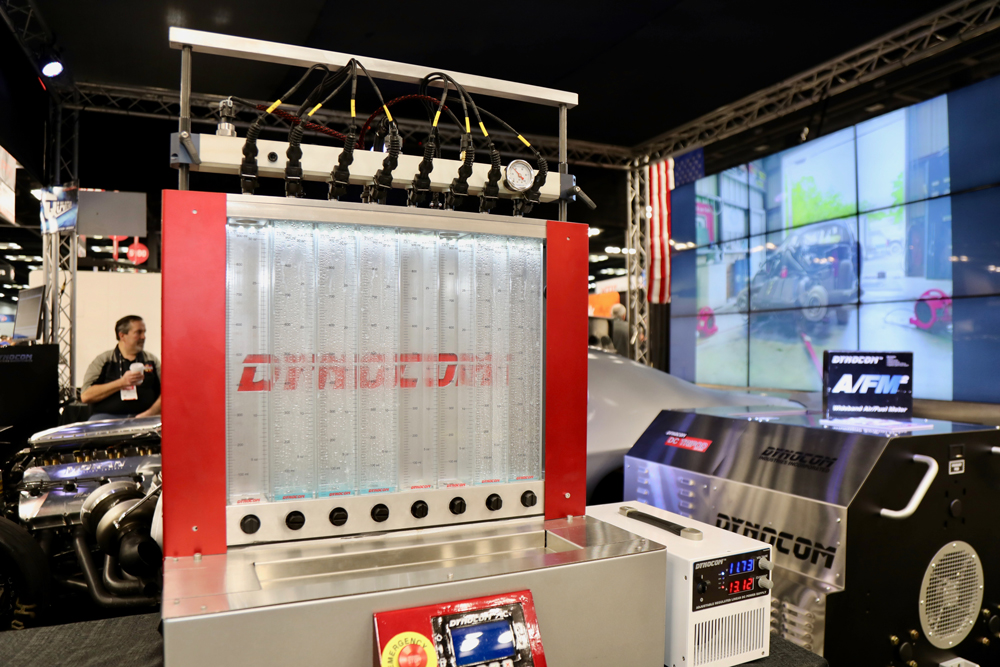
Another product offering an extra hand is the Steering Buddy from Hostile Industries in Anniston, Alabama. When connected to the steering shaft in the race car, it allows remote control for all steering operations. This action is helpful when moving a car into a trailer, around a garage, or through tech inspection.
“You can even operate it with a smartphone app,” said Mike Pearl, adding that his son Mike first approached him about developing such a device while working on a dirt-track race crew. “They were fighting to load it on a trailer. Sometimes the cars are hard to turn with some of the front-end settings.”
QA1 in Lakeville, Minnesota, just introduced another time saver in the shop, a ‘six pack’ of dry shocks that includes all the necessary parts to build custom shocks as well as backups in an easy-to-access box.
“We developed it for shock rebuilders. It has all the parts and pieces to build shocks that are custom valved to your specs,” said Dave Knauff. “A lot of work went into the packaging so that the users will have a productive open-box experience. By assembling all the pieces in bulk, we’re passing the cost savings onto the customer.”
Racers building their own cars may be more appealing in the future as fabrication equipment gets better and more affordable. Hammer Concepts & Designs in Adams, Tennessee, will set up a shop with a custom table and accessories so that just about any kind of chassis can be built from the ground up.

“Builders are looking for repeatability and faster builds,” said Reno King. “We offer fully adjustable, multi-purpose jigs that handle different axle housings, suspension designs, steering columns, and more.”
Meantime, Monit Motorsport in Mount Maunganui, New Zealand, has developed a very useful product that adjusts the front-rear brake bias and provides a built-in digital display so that the driver doesn’t get the settings mixed up.
“Drivers always want to know where the bias is. Sometimes they were afraid to change it because they weren’t sure they could return to the previous setting,” said Reuben Caldwell. “It’s waterproof, has its own internal battery, and always keeps the driver informed.”
Finally, Bolingbrook, Illinois-based Shaviv USA is touting its Mango II FR Ratcheting Countersink Set for cleaning in the inside diameter of holes. The kit includes an ergonomically designed Mango II handle, the FR ratchet holder, and F20 20-mm countersink blades.
Unlike a standard deburring tool, this piece “usually cleans out a hole in one turn,” Nicholas Prohl told us. “There’s a lot less fatigue on the hand, and the user can do multiple holes very fast.”
Even with all the new shop gear, chassis components, and other car-related products that will be available in the coming season, engine performance will likely remain in the headlines as competition heats up. There are still enough race classes where engine builders have freedom to build some serious horsepower combinations, but there will be cautionary stipulations.
“Everyone wants to make more power,” observed John Partridge of Bullet Racing Cams, Olive Branch, Mississippi. “But they also want keep those engines happy.”
 MEMBERSHIP LOGIN
MEMBERSHIP LOGIN JOIN PRI
JOIN PRI


